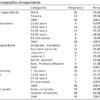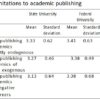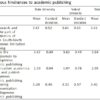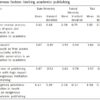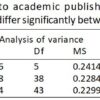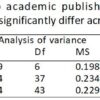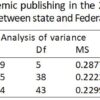© Media Watch | 12 (2) 352-363, 2021
ISSN 0976-0911 | E-ISSN 2249-8818
DOI: 10.15655/mw/2021/v12i2/160156
Evaluating the Limitations to Academic Publishing in
the 21st Century: Perception of Communication Academics
of Public Universities in South-South Nigeria
Ese Steven Umukoro & Joyce Ogho Ogwezi
Delta State University, Nigeria
Received: 22 December 2020| Accepted: 18 April 2021|Published: 10 May 2021
Abstract
Academic publishing is exciting and enjoyable, especially in the 21st century. However, this possibility may not be the case with communication academics of public/government universities in southern Nigeria (South-South). This gap necessitates the current study, which evaluated the perceived limitations to academic publishing in the 21st century among government universities’ communication academics in southern Nigeria. Anchoring on Motivation theory and adopting the survey design, data from 44 respondents were collected. Measures of central tendency were used to analyse the collected data. The Analysis of Variance (ANOVA) technique was applied to test the hypotheses. The study found that the perceived limitations to academic publishing among communication academics do not differ significantly across the categories of public universities. The study recommended that management of public universities offering mass communication and related courses should provide research infrastructures and Internet connectivity across and within campuses.
Keywords: Academic publishing, communication, academics, public universities, South-South Nigeria
Introduction
Publishing communicates knowledge discovered through research, and this knowledge, in turn, enhances teaching and learning. Sulo, Kosgei, Tuitoek, and Chelaugat (2012) highlighted the benefits of research and academic publishing. They stated that research leads to new knowledge, which consequently engenders innovations, while academic publishing disseminates the new knowledge generated. Both enhance the teaching staff’s quality and increase an institution’s reputation and economic status via patent rights.
Lee and Bound (2003) believe that publication rates largely determine crucial hiring, tenure, and promotion issues. They argued that faculty’s academic performance/research output has, over time, been assessed using “straight counts” of existing publications. Kyuik (2003), on his part, posited that educational institutions have mainly used the number of publications of academics as indicators or measures of performance. Thus making publication outputs of academics essential for securing funding/grants from governments and other available sources.
Since publishing the first peer-reviewed journal, “Philosophical Transactions of the Royal Society” in 1665, academic publishing has experienced tremendous growth and innovations. Elsevier (2014) stated that academic publishing has witnessed three stages of metamorphosis. The first stage was between 1665 and 1995, characterized by publishing the journal. The publishing process at this stage began and ended with the use of printing machines only. The second stage was between 1995 and 2008, characterized by computerized production for publishing, online dissemination of published works, and electronic submission and review of articles. These have culminated in faster, efficient, and increased accessibility, especially with the emergence of the electronic versions of the paper format. This stage witnessed rapid growth and expansion of publishing among academics. This stage also experienced the proliferation of academic journals and the professionalization of scholarly journals. The third and present stage is the 21st century publishing which started from 2008 till date. This stage is characterized by computerization and automation of the academic publishing processes, systems’ approach to publishing, and the creation and running of society based on knowledge generated from research and publishing.
Perception is an essential component of an individual because it is the prism through which individuals perceive the world. Perception is the spectacle with which individuals view their worlds. It is about how one perceives the world around him/her. McLeod, Wise, and Perryman (2017) contend that perception, being a significant concept among social science discourse, recognizes that “reality” is domiciled in the observer’s mind. They further argued that perception entails the ways and manners in which individuals view the world based on their respective experiences and predispositions of the past. Other factors that help shape perception in individuals are gender, race, social class, political ideology, and recent exposure.
Wien (n.d.) observed that most scholars see perception as a predetermined process explicitly designed to recognize, organize and simultaneously interpret sensory information. However, Wien differs from those scholars when he opined that through perception, people could interpret the world around them by developing a mental representation of their respective environment. Such mental representation may not generally be isomorphic to the world, yet it is subject to several corresponding differences and/or errors. No doubt, human brains can make assumptive interpretations about the environment and the world generally to overcome the presumed inherent ambiguity in available sensory data. In light of the above, this study’s focus is to evaluate perceived limitations to academic publishing in the 21st century among communication academics of public universities in southern Nigeria. The study will examine what communication academics of public/government universities in the country’s southern region perceive as limiting their successful academic publishing.
Enquiries into the limitations to academic publishing among Nigerian academics have attracted the attention of researchers. Studies have been conducted to examine the perceived limitations to academic publishing among lecturers and tutors in universities and other categories of higher institutions in the last century (Olukoju, 2002; Wadesango, 2014). The findings of these studies apply to specific categories of tertiary institutions like universities, or academics in mass communication subject, remains unanswered. This, however, creates a research gap which our study sets out to fill in. This study is motivated by the desire to determine whether the limitations to academic publishing identified by prior studies are peculiar to specific types of institutions. It will also examine whether the perception of academics on the limitations to academic publishing varies across different categories of Nigerian universities (State and Federal universities).
Research Objectives and Hypotheses
In light of the above, the study’s objective is to evaluate the limitations to academic publishing in the 21st century among academics in the field of mass communication. Specifically, the perception of communication academics of all public universities in South-South Nigeria will be sought to achieve the study’s broad objective. This study aims to:
(i) Examine the nature of the perceived limitations to academic publishing in the 21st century among communication academics of public universities in South-South Nigeria.
(ii) Ascertain whether the endogenous limitations to academic publishing are the same among communication academics across all categories of public universities in the region.
(iii) Determine whether the exogenous factors limitations to academic publishing vary significantly among communication academics of both the categories of public universities.
From the above objectives the following hypotheses are formulated:
H1: The perceived limitations to academic publishing in the 21st century among communication academics do not differ significantly between State and Federal universities.
H2: The endogenous limitations to academic publishing among communication academics are not significantly different across State and Federal universities.
H3: The exogenous limitations to academic publishing among communication academics do not vary significantly between State and Federal universities.
This paper is relevant in various ways. The outcome of this study will formulate policies for communication education in the universities of this region. The study will be beneficial to communication academics because it will help them improve on their research and academic publishing. Also, it will add to the existing literature in academic publishing limitations, especially among communication academics.
Literature Review
Conceptualizing Academic Publishing
Academic publishing as a concept has received scholarly attention. US Legal Inc. (2016) considers academic publishing–a publishing system that has remained essential for literary scholars, which demands the review of scholarly works before they are made available to various audiences. The US Legal Inc. further asserts that most research outcomes are published mainly in the revered journals, proceedings, or book forms. It also posits that modern academic publishing is commonly in electronic forms, cuts across various disciplines, and contributes to knowledge in several areas of discourse.
Academic publishing has its origin in England. The first peer-reviewed academic journal, Philosophical Transactions of the Royal Society was published in 1965. Publishing intellectual outcomes was controversial as discoveries were announced as an anagram such that priorities were given to the discoverers. However, this method did not work well, even though Isaac Newton, Leibniz, and other top scholars used it
(Elsevier, 2014). This approach generated lots of disputes which reduced gradually as academic publishing gained momentum. Lending its voice to the concept of scholarly publishing, Elsevier (2014) argues that contemporary academic publishing must go through a review process. Peer review refers to the process of critically assessing an academic paper. It is usually done on a blind basis by more than one knowledgeable referees/reviewers in a similar or the same field of study as the writer. The content of the submitted research paper is duly checked and scrutinized by the reviewer(s), who determines its suitability for publication in the prescribed journal. Through this process, research papers are required to undergo series of reviews and revisions before a decision is reached on their acceptance or rejection. Following the emergence of the peer review process since 1752, the standard and quality of academic publishing have increased, reducing the level of plagiarism globally.
The 21st Century Academic Publishing
Elsevier (2014) describe extensively about academic publishing in the 21st century environment. It stated that academic publishing is the product of two desires. They are “the desire by an individual to acquire information” and “the desire by an individual to disseminate information.” It also stated that seven desires characterize the 21st century academic publishing environment. The first characteristic is the longing to acquire knowledge and learn in a standard way. The second characteristic is the desire to supplement knowledge. The third characteristic is the craving for more knowledge in one’s field to keep up-to-date with new developments in the researcher’s field, not only with articles published in journals but also in fora such as discourses and sessions. The fourth characteristic is the desire and pressure by both the researcher’s institute and the scientific community to publish findings. Fifth is the desire to claim the patent right to officially recognize “being the first to have discovered something,” which includes possibly financial reward from such a patent. Sixth is a desire to build peer recognition. Seventh and last is the desire to receive a monetary reward as royalty.
The best form of publishing entails multiple sources of getting knowledge, multiple platforms to increase and expand knowledge, and abreast with the latest research and developments. However, communication academics of public universities in South-South Nigeria are not exploring and enjoying these potentials of the academic publishing environment.
There are seven public universities offering communication studies in Southern Nigeria (Nigerian Scholars, 2020). They are Cross Rivers University of Technology, Calabar, Cross Rivers State; University of Calabar, Calabar, Cross Rivers State; Delta State University, Abraka, Delta State; University of Port Harcourt, Port-Harcourt, Rivers State; Rivers State University of Science and Technology, Port Harcourt, Rivers State; University of Benin, Benin city, Edo State; and University of Uyo (UNIUYO), Uyo, Akwa Ibom State.
Olukoju’s (2002) study, which focused on assessing the presumed challenges of research and academic publishing among universities in Nigeria in the 20th century, highlighted some limitations to research and academic publishing. Olukoju identified limitations such as the economic crisis of the early 1980s, which resulted in the neglect of tertiary education, the preoccupation of the senior generation of academics with either university administration or external politics, and the carrot-and-stick policy towards universities in Nigeria by military juntas, especially that of General Ibrahim Badamosi Babangida. Other limitations enumerated by Olukoju are the prolonged military juntas which lacked accountability but embraced the culture of treasury looting and obscurantism, collapse of the local currency. The above limitations forced academics of Nigerian universities to be diverted from their primary assignments of teaching and research. Mostly the academics were concentrated on self-survival, leading to “brain-drain.” Olukoju’s study also revealed that the battered economy hindered research and scholarly publishing among academics of Nigerian universities.
In another study on impairments to successful research and publication, Wadesango (2014) has identified that the inability of most academics is to understand the essence of research, lack of adequate research skills among academics, lack of time and funds for research, among the several drawbacks.
Theoretical Framework
This study is anchored on Motivation theory. Obagbinoko and Egbadju (2011) discussed Herzberg’s theory of motivation and reiterated that the theory dwelt on factors that motivate employers in their jobs. Frederick Herzberg, an American psychologist, developed two broad factors that motivate employees in their jobs. These are the “hygiene factors” and the “motivators factors.” The hygiene factors are the organization’s policy, organization’s supervision, staff’s interpersonal relations, working conditions, and staff remuneration. On the other hand, the motivating factors are accomplishing a task, acknowledging such accomplishment by the superiors, responsibilities, and advancement in the job. The motivating factors are factors that directly motivate employees to work better. Herzberg further stated that the absence of any of the two broad factors could cause job dissatisfaction. For an employee to be entirely motivated in his/her employment, both the hygiene and motivators factors need to combine well and adequately. This theory is apt for this study because if communication academics of universities are well motivated, they will engage in research and academic publishing.
Methodology
The study adopted the survey research method. Sobowale (2008) opines that survey is the most common technique used in social science research. It entails drawing up questions on various aspects of the subject matter that selected population members are expected to respond to. For Babbie (2010), a survey is used for studies where individuals are the unit of analysis. This study was carried out among communication academics of public universities in South-South Nigeria. Southern Nigeria consists of six states: Akwa Ibom, Bayelsa, Cross River, Delta, Edo, and Rivers. There are seven public universities offering mass communication or related courses in the region. (Nigerian Scholars, 2020). Cross Rivers University of Technology has a staff of 18, whereas University of Calabar, the number is 27 in the communication department. There are 13 staff each in the Delta State University and the University of Port Harcourt. The Rivers State University of Science and Technology and the University of Benin have staff strength of 10 each. The University of Uyo has staff strength of 19. The above figures give a total staff strength of 110 communication academics of the seven public universities in South-South Nigeria, which form this study population. The study includes only communication academics who are not professors (the highest rank among university academics) and those who are not on leave of absence of any kind. Professors were purposively excluded because they have attained the zenith of academic publishing. Also, communication academics on leave of absence were equally excluded. A sample of 44 was considered for the study using the sample size proposition made by Nwana, who proposed that “ïf the population of a study is a few hundred, a 40% or more sample can be considered for the study” (Nwana, 1981). Tuckman (1972) equally argues that the primary issue in the choice of sample size is that it should sufficiently assure the researcher that the sample will represent the population from which it is drawn.
Results and Discussion
Table 1 shows the demographic characteristics of the respondents. Thirty-one (70.46%) represent male respondents, while 13 (29.54%) are females. On the age of the respondents, 14 (31.82) are within 31-40 years, the majority among the study population. This is followed by 12 respondents within ages 41-50 years (27.27%). Eight respondents (18.18%) are within 51-60 years. Respondents within 21-30 years are the least in age category followed by those 61 years and above are 6 (13.64%). On the respondents’ rank, 12 (27.27%) are Lecturer II, followed by Assistant Lecturer 11 (25.00%). Lecturer I and senior Lecturer have the same number of 7 (15.91%) respondents. The last rank of the respondents is two Graduate Assistants (4.55%), followed by Readers/Associate Professors, whose number is five (11.36%). On years of teaching experience, 23 respondents (52.27%), which is the majority have put 1-10 years in the teaching job, 12 respondents (27.27%) have 11-20 years, while, seven respondents (15.91%) have 21-30 years of teaching experience. The least in this category is 2 (4.55%) who have 31 and above years of experience in the teaching. In the public university category, 29 respondents (65.91%), the majority, are from Federal universities while the remaining 15 respondents (34.09%) are from State universities in the region.
Table 2 shows data concerning to participants’ take on the nature of the limitations to academic publishing. As observed, State university participants’ mean response was 3.33 with a standard deviation of 0.62. Similarly, Federal university participants’ responses showed a mean of 3.41 and a corresponding standard deviation of 0.63. The total mean was 3.39. Going by this result, it is evident that most of the respondents agree that the limitations to academic publishing among communication academics of public universities in South-South Nigeria are partly endogenous.
On the issue of exogenous factors limiting to academic publishing, Table 2 data shows, State university participants’ mean response was 3.27 with a standard deviation of 0.46. Similarly, Federal university participants’ responses revealed a mean of 3.38 and a corresponding standard deviation of 0.49. The total mean was 3.34. By this result, it is evident that most of the respondents agree that the limitations to academic publishing among communication academics of public universities are partly exogenous.
Similarly, the State university participants’ responses revealed a mean value of 3.13 with a standard deviation of 0.64 on the negative effects of thier academic careers. Federal university participants’ responses showed a mean of 3.38 and a corresponding standard deviation of 0.68. The total mean was 3.30. Therefore, it is evident that most of the respondents agree that the limitations to academic publishing among communication academics of public universities in South-South Nigeria have negative effects on their academic prospects. It means that the limitations are hindering their growth in their academic careers.
Table 3 presents data concerning to the respondents’ opinion on endogenous limitations to academic publishing. As observed, State university participants’ responses revealed a mean of 3.47 with a standard deviation of 0.52 about lack of adequate research and analytical skills. Similarly, Federal university participants’ responses showed a mean of 3.41 and a corresponding standard deviation of 0.63 on the said issue. The total mean was 3.43. It is evident from this result that most of the respondents agree that lack of adequate research and analytical skills of communication academics is an endogenous limitation to academic publishing. This finding alings with Wadesango’s (2014) study.
On the issue of lack of knowledge on the availability of good journals, Table 3 shows that State university participants’ mean response was 3.67 with a standard deviation of 0.49 and for Federal university the mean was 3.62 with a corresponding standard deviation of 0.49. The total mean was 3.64. Going by this result, it is evident that most of the respondents strongly agree that lack on knowledge on the availability of good journals to publish in is another endogenous limitation to academic publishing.
We also observed the responses from participants of State universities with a mean value of 2.20 and a standard deviation of 0.94 on the issue of laziness of communication academics. Similarly, Federal university participants’ responses showed a mean of 1.97 and a corresponding standard deviation of 0.78. The total mean was 2.05. It is evident from this result that most of the respondents did not agree that the laziness of the academics to conduct research and publish research papers is an endogenous limitation to the publishing.
On the issue of lack of proper mentoring capabilities among communication academics, the mean response was 3.20 with a standard deviation of 0.86. For Federal university response the mean was 3.52 with a corresponding standard deviation of 0.57. The total mean was 3.41. This result shows that most participants agree that lack of mentoring capabilities of communication academics is an endogenous limitation to academic publishing. The above finding aligns with Olukoju’s (2002) and Wadesango’s (2014) study.
Table 4 shows data concerning to the respondents’ take on exogenous factors limitation to academic publishing among communication academics. State university participants’, responses revealed a mean value of 3.13 with a standard deviation of 0.64 and for Federal university participants’ the a mean value was 2.94 and a corresponding standard deviation of 0.75. The total mean was 3.00. It is evident from this result that most respondents agree that the standard peer-review process set by good and high-impact journals is an exogenous limitation to academic publishing.
As observed in Table 4, State university participants’ responses on research infrastructure revealed a mean value of 3.67 with a standard deviation of 0.49; while Federal university participants’ responses showed a mean of 3.59 and a corresponding standard deviation of 0.49. The total mean was 3.61. This result shows that most respondents strongly agree that the dearth of research infrastructures such as free Internet connectivity within campuses is another exogenous limitation to academic publishing.
Similarly, State university participants’ responses on high cost of publishing revealed a mean response of 3.47 with a standard deviation of 0.52. Federal university participants’ responses showed a mean of 3.62 and a corresponding standard deviation of 0.78. The total mean was 3.57. It is evident from this result that most of the respondents strongly agree that the associated high cost of publishing academic papers with high-impact journals is yet another exogenous limitation to scholarly publishing.
On the issue of budgetary provisions, State university participants’ mean response was 1.67 with a standard deviation of 0.49; where as, Federal university participants’ responses showed a mean of 2.14 and a corresponding standard deviation of 0.57. The total mean was 1.98. Going by this result, it is evident that most of the respondents disagree that the level of budgetary provisions to public universities in South-South Nigeria is an exogenous limitation to academic publishing. This implies that for communication academics who are determined to conduct research and publish their findings, the level of budgetary provisions is not a limitation to them. This finding contradicts with Wadesango’s (2014) study, who found that lack of budgetary provision impedes research output and publication.
Hypotheses Testing
H1: The perceived limitations to academic publishing in the 21st century among communication academics do not differ significantly between State and Federal universities.
The study’s first hypothesis was tested using one-way ANOVA, and results are presented in the above table. As indicated in the table, the value of Fcal = 1.06 and the corresponding p-value = 0.3992. Since F-value < the table value (Fcrit = x >2.45 < 2.53), the null hypothesis that the perceived limitations to academic publishing do not differ significantly between State and Federal universities.
H2: Endogenous limitations to academic publishing in the 21st century among communication academics do not significantly differ across State and Federal universities.
The second hypothesis was tested using one-way ANOVA, and the results are presented in the above table. The value of Fcal is 0.85, while the corresponding p-value is 0.5434. Since the F-value is less than the table value (Fcrit = x >2.34 < 2.25), the null hypothesis, that is the endogenous limitations to academic publishing do not differ significantly between State and Federal universities and the hypothesis can not be rejected. We, therefore, conclude that the perceived limitations to academic publishing in the 21st century do not differ significantly across public universities in southern Nigeria.
H3: Exogenous limitations to academic publishing in the 21st century among communication academics do not vary significantly between state and Federal universities in South-South Nigeria.
The third hypothesis was tested using one-way ANOVA, and the results are presented in the above table. As indicated, the value of Fcal = 1.29, and the corresponding p-value is 0.2867. Since F-value < table value (Fcrit = x >2.45 < 2.37), the null hypothesis that the exogenous limitations to academic publishing in the 21st century do not differ significantly between State and Federal universities in South-South Nigeria and it can not be rejected.
Conclusion
The study sought to evaluate the limitations to academic publishing in the 21st century among communication academics of public universities in South-South Nigeria. The study found that academic publishing’s perceived limitations among communication academics are endogenous and exogenous. Specifically, lack of adequate research and analytical skills of communication academics and lack of knowledge of good journals to publish in are of the endogenous factors inhibiting academic publishing. The study showed that the shortage of research infrastructures such as Internet connectivity within campuses and the associated high cost of publishing academic papers in high-impact journals are part of the exogenous limitations of academic publishing. The study observed that the perceived limitations to academic publishing do not differ significantly between both Federal and State universities. It was observed that both the endogenous and exogenous factors inhibiting academic publishing do not differ significantly across public universities. Based on the above findings, it is recommended that: (i) there should be regular sensitization among communication academics in universities on the availability of good journals to publish in, academics in the department of mass communication and related fields should be encouraged to develop their research and communication skills through training, and universities offering communication or related courses should make efforts to provide research infrastructure.
Conflict of interest: The authors declared no potential conflicts of interest concerning the research, authorship, and/or publication of this article.
Funding: The authors received no financial support for the research, authorship, and/or publication of this article.
References
Babbie, E. (2010).The practice of social research (12thed). United States: Wadsworth.
Elsevier. (2014). Publishing in the 21st century what’s changed: History and future of scholarly communication challenges and perspectives. Retrieved from http://biblioteka.pmwsz.opole.pl>12=jlewczuk.
Kyuik, S. (2003). Changing trends in publishing behaviour among university faculty, 1980-2000. Scientometrics, 58, 35-48.
Lee, A. & Boud, D. (2003). Writing groups, change, and academic identity: Research development as local practice. Studies in Higher Education, 28(2), 187-200. doi:10.1080/0307307032000058109
Mcleod, D. M., Wise, D. & Perryman, M. (2017). Thinking about the media: A review of theory and research on media perceptions, media effects perceptions, and their consequences. Review of Communication Research, 5, 35-83. doi: /10.12840/issn.2255-4165.2017.05.01.013
National Bureau of Statistics. (2018). 2017 Demographic statistics bulletin. Retrieved from www.nigerianstat.gov.ng.
Nigerian Scholars. (2020). List of universities that offer mass communication. Retrieved from https://nigerianscholars.com/school-finder/mass-communication.
Nwana, O. C. (1981). Introduction to educational research for student teachers. Ibadan: Heinemann Educational Books Ltd.
Obagbinoko, C. & Egbadju, A. (2011).Theories, themes, and concepts common in the study of the social sciences. In Awaritefe, O.D. and Mukoro, A. (Eds,) Philosophy of the Social Science 24-34. Abraka: DIL Printing Press.
Olukoju, A. (2002). The crisis of research and academic publishing in Nigerian universities: The twentieth century and beyond. Paper presented at the 28th Annual Spring Symposium, “African Universities in the Twenty-First Century” at University of Illinois/CODESRIA, Dakar, Senegal from 25th to 27th April, 2002.
Sobowale, I. (2008). Scientific journalism. Lagos: Idesa Consult.
Sulo, T., Kendagor, R., Kosgei, D., Tuitoek, D. & Chelangat, S. (2012). Factors affecting research productivity in public universities in Kenya: The case of Moi University, Eldoret. Journal of Emerging Trends in Economics and Management Sciences, 3(5), 475-484. doi:10.10520/EJC127672
Tuckman, B. W. (1972). Conducting educational research. New York: Harcourt Brace Jovanovich Inc.
US Legal Inc. (2016). Academic Publishing Law and Legal Definition. Retrieved from http:// www.definitions.uslegal.com/a/academic -publishing.
Wadesango, N. (2014). Publish or perish: Impediments to research output and publication. International Journal of Education Science, 6(1), 57-63. doi:10.1080/09751122.2014.11890118
Wien, T.U. (n.d.). Human perception and information processing. Retrieved from http://www.ifs.tuwien.ac.at/~silvia/wien/vuinfovis/articles/Chapter3_HumanPerceptionAndInformationProcessing_73-128.pdf.
Wikipedia (n.d). South-South (Nigeria). Retrieved from https://en.wikipedia.org/wiki/South_South_Nigeria.
Wimmer, D. R. & Dominick, J. R. (2006). Mass media research: An introduction (8th Edition). Boston, MA: Wadsworth Cengage Learning.
Ese Steven Umukoro is a Lecturer in the Department of Mass Communication at Delta State University, Nigeria. He specializes in communication and media studies.
Joyce Ogho Ogwezi (Ph.D., Development Communication, University of Ibadan, 1992) is a senior Lecturer in the Department of Mass communication at Delta State University, Nigeria. Her area of specialization is development communication.
Correspondence to: Ese Steven Umukoro, Department of Mass Communication, Delta State University, P.M.B. 1, Abraka, Nigeria.
This article is distributed under the terms of the Creative Commons Attribution 4.0 License (https://creativecommons.org/licenses/by/4.0/), which permits any use, reproduction and distribution of the work without further permission provided the original work is attributed properly. The article may be reused without special permission provided that the original article is properly attributed. Reuse of an article does not imply prior approval by the authors or Media Watch.
